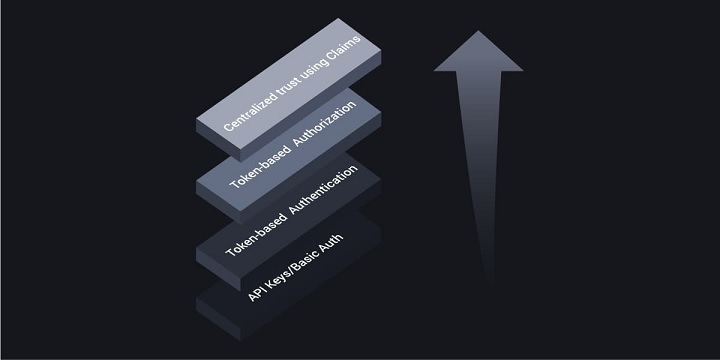JFrog announced a new machine learning (ML) lifecycle integration between JFrog Artifactory and MLflow, an open source software platform originally developed by Databricks.
APIs (Application Programming Interfaces) are incredibly important in today's digital landscape. They play a crucial role in enabling communication and interaction between different software applications, systems, and services. Due to the increasing reliance on APIs, they have gradually become the top target for hackers. As such, enterprises are placing more emphasis on API security to protect the integrity of data and services, build trust and confidence, and mitigate future risks.
This blog will explore the different levels of API security by examining the API Security Maturity Model, a framework in which security and trust increase according to each level. The higher up on the model, the better organizations are equipped to protect their systems more efficiently.
The API Security Maturity Model is divided into four layers:
Level 0: API Keys and Basic Authentication
Level 1: Token-Based Authentication
Level 2: Token-Based Authorization
Level 3: Centralized Trust Using Claims

Level 0: API Keys and Basic Authentication
API keys and basic authentication, common methods for API security, are considered level 0. Both of these methods provide authentication to protect API resources. However, API keys can easily be compromised as they can only verify from machine to machine without considering the user's identity. In many cases, API keys are not renewed, so an attacker can use them maliciously for a long time.
In addition, API keys and basic authentication don't cover the authorization process. Authorization is vital as it helps determine the actions the user can perform within a system and whether they have permission to access certain resources or data.

Level 1: Token-Based Authentication
Token-based authentication is a user authentication method commonly used in web applications and APIs. Instead of using traditional username and password credentials, token-based authentication relies on access tokens to authenticate users and grant them access to protected resources. However, anyone with the access token can modify the API and gain access to the protected resources, as authorization is still not part of the process.

Level 2: Token-Based Authorization
In level 2 of the API Security Maturity Model, a token-based architecture is used for authorization. Token-based authorization is a method of controlling access to resources in web applications and APIs based on the presence and validity of a token. This token is generated during the authentication process and contains information about the user's identity and permissions.
APIs in level 2 use OAuth 2.0, an industry-standard authentication and authorization protocol used to grant third-party applications limited access to user resources on a web service without requiring the user to share their login credentials directly with the application. One of the advantages of OAuth is Scopes. Scopes enable access tokens issued to clients to use only restricted privileges.
The main issue with level 2 is that not all values used for API authorization are supplied securely. Even though a token is used to access a user's resources, other values may be passed in plain HTTP headers or URL path segments. A malicious party could potentially alter these values to elevate their privileges.
Level 3: Centralized Trust Using Claims
Level 3 is the most advanced tier of the API Security Maturity model, thus providing the highest level of security for your APIs. At this level, the API receives all secure values in access tokens delivered in a JSON web token (JWT) format. If these values are altered, the JWT will fail cryptographic validation. Such values are called claims and might include a user ID, company ID, and roles. Claims aid in the authorization or authentication of a user by providing more contextual information regarding the issued token and who the issuer is. Claims help to build an identity-based API security system that validates the identity of the user and their level of access to applications, resources, or services.
Conclusion
It is now more critical than ever for enterprises to adopt robust API security practices to protect their resources and users. The API security maturity model delineates the different levels of API security from very basic to advanced implementations. As explained, API keys are not adequate to secure modern APIs. An identity-centric approach based on claims is required to ensure the highest level of authentication and authorization of the user.
Industry News
Copado announced the general availability of Test Copilot, the AI-powered test creation assistant.
SmartBear has added no-code test automation powered by GenAI to its Zephyr Scale, the solution that delivers scalable, performant test management inside Jira.
Opsera announced that two new patents have been issued for its Unified DevOps Platform, now totaling nine patents issued for the cloud-native DevOps Platform.
mabl announced the addition of mobile application testing to its platform.
Spectro Cloud announced the achievement of a new Amazon Web Services (AWS) Competency designation.
GitLab announced the general availability of GitLab Duo Chat.
SmartBear announced a new version of its API design and documentation tool, SwaggerHub, integrating Stoplight’s API open source tools.
Red Hat announced updates to Red Hat Trusted Software Supply Chain.
Tricentis announced the latest update to the company’s AI offerings with the launch of Tricentis Copilot, a suite of solutions leveraging generative AI to enhance productivity throughout the entire testing lifecycle.
CIQ launched fully supported, upstream stable kernels for Rocky Linux via the CIQ Enterprise Linux Platform, providing enhanced performance, hardware compatibility and security.
Redgate launched an enterprise version of its database monitoring tool, providing a range of new features to address the challenges of scale and complexity faced by larger organizations.
Snyk announced the expansion of its current partnership with Google Cloud to advance secure code generated by Google Cloud’s generative-AI-powered collaborator service, Gemini Code Assist.
Kong announced the commercial availability of Kong Konnect Dedicated Cloud Gateways on Amazon Web Services (AWS).
Pegasystems announced the general availability of Pega Infinity ’24.1™.




